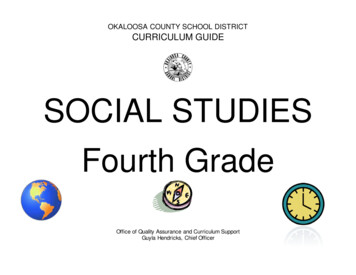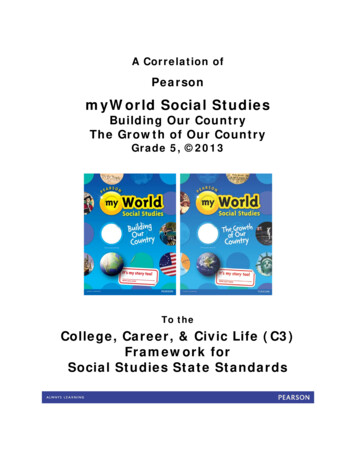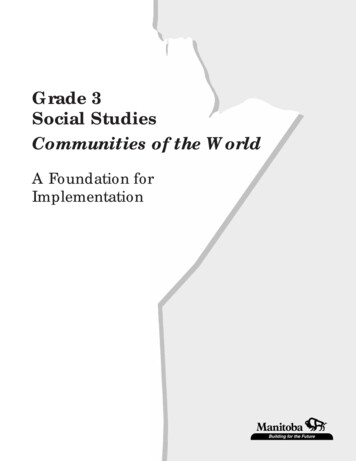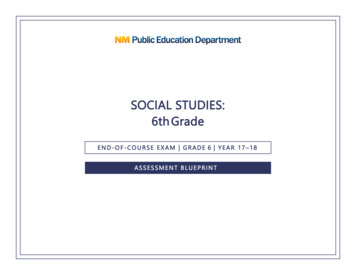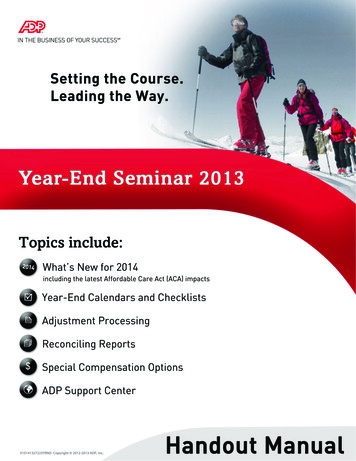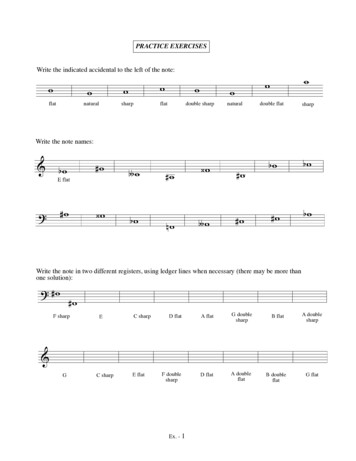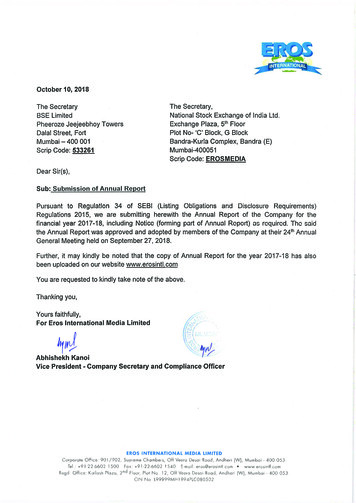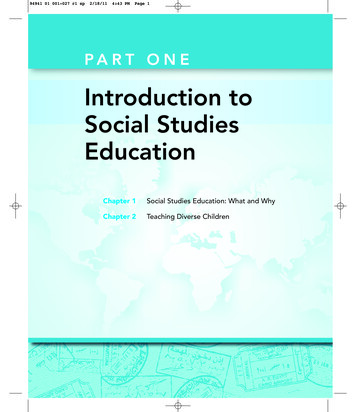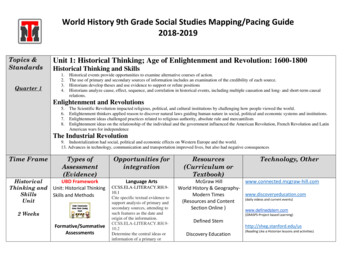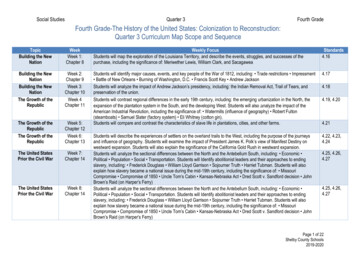
Transcription
Social StudiesQuarter 3Fourth GradeFourth Grade-The History of the United States: Colonization to Reconstruction:Quarter 3 Curriculum Map Scope and SequenceTopicBuilding the NewNationWeekWeek 1:Chapter 8Weekly FocusStudents will map the exploration of the Louisiana Territory, and describe the events, struggles, and successes of thepurchase, including the significance of: Meriwether Lewis, William Clark, and SacagaweaStandards4.16Building the NewNationBuilding the NewNationThe Growth of theRepublicWeek 2:Chapter 9Week 3:Chapter 10Week 4Chapter 114.17The Growth of theRepublicThe Growth of theRepublicWeek 5:Chapter 12Week 6:Chapter 13Students will identify major causes, events, and key people of the War of 1812, including: Trade restrictions Impressment Battle of New Orleans Burning of Washington, D.C. Francis Scott Key Andrew JacksonStudents will analyze the impact of Andrew Jackson’s presidency, including: the Indian Removal Act, Trail of Tears, andpreservation of the union.Students will contrast regional differences in the early 19th century, including: the emerging urbanization in the North, theexpansion of the plantation system in the South, and the developing West. Students will also analyze the impact of theAmerican Industrial Revolution, including the significance of: Watermills (influence of geography) Robert Fulton(steamboats) Samuel Slater (factory system) Eli Whitney (cotton gin).Students will compare and contrast the characteristics of slave life in plantations, cities, and other farms.4.22, 4.23,4.24The United StatesPrior the Civil WarWeek 7:Chapter 14The United StatesPrior the Civil WarWeek 8:Chapter 14Students will describe the experiences of settlers on the overland trails to the West, including the purpose of the journeysand influence of geography. Students will examine the impact of President James K. Polk’s view of Manifest Destiny onwestward expansion. Students will also explain the significance of the California Gold Rush in westward expansion.Students will analyze the sectional differences between the North and the Antebellum South, including: Economic Political Population Social Transportation. Students will Identify abolitionist leaders and their approaches to endingslavery, including: Frederick Douglass William Lloyd Garrison Sojourner Truth Harriet Tubman. Students will alsoexplain how slavery became a national issue during the mid-19th century, including the significance of: MissouriCompromise Compromise of 1850 Uncle Tom’s Cabin Kansas-Nebraska Act Dred Scott v. Sandford decision JohnBrown’s Raid (on Harper’s Ferry)Students will analyze the sectional differences between the North and the Antebellum South, including: Economic Political Population Social Transportation. Students will Identify abolitionist leaders and their approaches to endingslavery, including: Frederick Douglass William Lloyd Garrison Sojourner Truth Harriet Tubman. Students will alsoexplain how slavery became a national issue during the mid-19th century, including the significance of: MissouriCompromise Compromise of 1850 Uncle Tom’s Cabin Kansas-Nebraska Act Dred Scott v. Sandford decision JohnBrown’s Raid (on Harper’s Ferry)4.184.19, 4.204.214.25, 4.26,4.274.25, 4.26,4.27Page 1 of 22Shelby County Schools2019-2020
Social StudiesThe United StatesPrior the Civil WarWeek 9:Chapter 15The United StatesPrior the Civil WarWeek 10:Chapter 15Quarter 3Fourth GradeStudents will Explain how slavery became a national issue during the mid-19th century, including the significance of: Missouri Compromise Compromise of 1850 Uncle Tom’s Cabin Kansas-Nebraska Act Dred Scott v. Sandford decision John Brown’s Raid (on Harper’s Ferry)Students will Explain how slavery became a national issue during the mid-19th century, including the significance of: Missouri Compromise Compromise of 1850 Uncle Tom’s Cabin Kansas-Nebraska Act Dred Scott v. Sandford decision John Brown’s Raid (on Harper’s Ferry)4.28, 4.294.28, 4.29Page 2 of 22Shelby County Schools2019-2020
Social StudiesQuarter 3Fourth GradeFourth Grade-The History of the United States: Colonization to Reconstruction:Quarter 3 Curriculum Map IntroductionWhat Will Fourth Grade Students Learn This Year?Fourth grade students will learn about the early development of democratic institutions, including the ideas and events that led to the independence of the ThirteenColonies, the American Revolution, and the formation of a national government under the Constitution. Students will continue their studies with the developmentand growth of the United States through Manifest Destiny and the division of our country. Finally, students will explore the causes and effects of the Civil War andReconstruction. Students will utilize primary source documents, geographic tools, analysis, and critical thinking within this concentrated study of early U.S. history.Planning with the Curriculum MapThe purpose of curriculum maps is to help teachers pace the year to ensure all the standards within a course will be addressed and taught. Curriculum maps offera sequence for delivering content and provide a clear scope for what must be taught to all students based on the Tennessee Social Studies Standards. Pleasekeep in mind that the curriculum map is meant to be a component of effective planning and instruction; it is not meant to replace teacher planning or instructionalpractice.Weekly Guidance for Gibbs Smith: The United States Though Time-4th GradeThe K-5 Social Studies curriculum maps provide weekly guidance to support teachers in their teaching. In an effort to support teachers, curriculum maps highlightthe Studies Weekly anchor text, supplemental texts, primary and secondary sources, suggested instructional strategies and tasks, and suggested assessments.Although the curriculum maps allow flexibility and encourage teachers to make thoughtful adjustments, there is an expectation that all children have access torigorous content and effective teaching practices. It is recommended that K-2 students receive 30 minutes of instruction every other day of the week (60-90minutes per week). It is also recommended that 3-5 students receive 30 minutes per day of social studies instruction (150 minutes per week).Online Access to Gibbs Smith: The United States Though Time-4th GradeTeachers may access The United States Though Time-4th Grade online using the following credentials methods:1. Go www.digital.experiencestatehistory.com and log in with username: shelby4@scs.org and password: countyPage 3 of 22Shelby County Schools2019-2020
Social StudiesQuarter 3Fourth GradeSupport StrategiesTo support students in understanding various texts and primary and secondary sources, the curriculum maps suggest an array of protocols and resources to useduring instruction. Some of the support strategies and connected classroom materials may be found below:Back-to-Back and Face-to-FaceCarousel BrainstormGive One, Get One, Move OnExpeditionary Learning: Protocols and ResourcesFinal WordFishbowlJigsawPage 4 of 22Shelby County Schools2019-2020
Social StudiesQuarter 3Fourth GradeWeek 1: Exploring Louisiana Territory-Chapter 8Essential Question(s)What were the struggles and successes of the Louisiana Purchase?StandardsTexts4.16 Map the exploration of the Louisiana Territory, and describe the events, struggles, and successes of the purchase, including the significance of: Meriwether Lewis,William Clark, and Sacagawea.4th Grade Textbook-Gibbs Smith: The United States Through Time (username: shelby4@scs.org /password: county)VocabularyLouisiana Territory, Louisiana Purchase, Corps of Discovery, expeditionTeacher Guided TextSpecific & TextDependent QuestionsAfter Washington (p. 78) Who was John Adams and why did people become angrywith him? Why was Thomas Jefferson elected president? Who controlled the Louisiana Territory? Why was the Mississippi River important to Americans atthe time? What concerns did Americans have about the MississippiRiver and Spain?The Louisiana Purchase (p. 79) Who took the Louisiana Territory from Spain? Why did President Jefferson fear Napoleon Bonaparte andFrance? What was the role of James Monroe? What was the Louisiana Purchase? How did the Louisiana Purchase impact the size ofAmerica?The Lewis and Clark Expedition (p. 80) What did President Jefferson do out of excitement for theLouisiana Purchase? Who did Jefferson choose to lead the expedition? How did William Clark become a part of the expedition andwhy?The Corps of Discovery (p. 80) What was a key thing Lewis and Clark needed for theirexpedition? How many men joined their team?The Journey Begins (p. 80) When did the Corps of Discovery set out andwhere did they leave from? How long did the travel? When did they stop and where did they stop? What did they do when they stopped in the NorthDakota Territory?Charbonneau and Sacajawea (p. 80-81) When did the Corps of Discovery meetCharbonneau and Sacajawea? How did assistance from Charbonneau andSacajawea greatly benefit the Corps ofDiscovery?Sacajawea (p. 82) How do people know Sacajawea? How did Sacajawea help her people and theexplorers understand each other? What are some mysteries about Sacajawea?Searching for the Pacific Ocean (p. 83) What proved to be the most difficult part of theLewis and Clark expedition and why? When did the men reach the Pacific Ocean andhow long did it take them to get there? What did the journey over the mountains prove?A Successful Journey (p. 84) How long did the Lewis and Clarkexpeditions last? How did Lewis and Clark share theirdiscoveries with others? How did President Jefferson thank Lewisand Clark? What discoveries did the Lewis, Clark, andthe Corps record on their journey? What did their expedition tell people aboutthe United States?William Clark (p. 86) What was Clark’s job or profession by theage of 19? How did Clark feel when Meriwether askedhim to join him on exploration of theLouisiana Territory? About how long was the expedition? What did Clark name his son? What political positions did William Clarkserve in?Meriwether Lewis (p. 86) Where did Lewis and Clark meet? What political positions did Lewis havebefore the exploration of the LouisianaTerritory? Who did Lewis meet with prior to setting outto explore the Louisiana Territory and why?Page 5 of 22Shelby County Schools2019-2020
Social StudiesQuarter 3 What professions did the men have prior to joining theteam? What relationships did Lewis and Clark have with some ofthe men on the team? Why did George Droulliard seem beneficial to the team ofmen? Who was York? What was Corps of Discovery?Fourth Grade How were Lewis and Clark thanked for theirexploration work?Suggested Protocols andResourcesBack to Back Face to FaceExtension Activities1) Using page 46 of the Teacher’s Edition Assessment Book, students will choose one of the adventurers from the Corps of Discovery and create a Facebook page forthat person along with five posts about actual events that took place on the journey of the Corps of Discovery. Students can be creative, but must remember that postsmust be historically accurate.2) Using page 48 of the Teacher’s Edition Assessment Book, students will examine the map of Lewis and Clark’s route in their textbook answer document basedquestions.Lewis and Clark: Interactive MapLouisiana Purchase: Text and MapStudent will write to answer the prompt: What were some successes and struggle of purchasing the Louisiana Territory? Be sure to include who contributed to thesuccesses and what features contributed to the struggles?Additional Topic SpecificResourcesAssessmentBack to Back Face to FaceMore Explores Map the West (p. 86) What was the Pike Expedition? How many expeditions did John Fremontlead? How did John Fremont’s work benefitothers?Back to Back Face to FacePage 6 of 22Shelby County Schools2019-2020
Social StudiesQuarter 3Fourth GradeWeek 2: The War of 1812 -Chapter 9Essential Question(s)TextsWhat were the causes of the War of 1812?Who were key figures of the War of 1812 and why?4.17: Identify major causes, events, and key people of the War of 1812, including: Trade restrictions Impressment Battle of New Orleans Burning of Washington,D.C. Francis Scott Key Andrew Jackson4th Grade Textbook-Gibbs Smith: The United States Through Time (username: shelby4@scs.org /password: county)VocabularyCensus, Battle of New Orleans, blockade, impressment, War of 1812, Washington, DCTeacher Guided TextSpecific & TextDependent QuestionsThe Population of the Country (p.89) What is a census? What did the census of 1800 tell about thepopulation of America? What did the census of 1810 tell about thepopulation of America?StandardsFighting Over Land (p. 89) What impact did the growing populationhave on American Indians? What did American Indians fear and why?Tecumseh Tries to Unify Indians (p. 90) Why did Shawnee war chief Tecumsehurge tribes to join together in aconfederation? What was the battle of Tippecanoe? How did General William Henry Harrisbecome known as a hero?War in Europe Effects Americans (p. 90) What countries were at war in Europe? Who did the United States side with duringthe war? How did the United Station initially benefitfrom the war in Europe? Why did the success of profit stop for theUnited States during the war in Europe?Taking American Soldiers (p. 91) Why did the British practice impressment onAmerican sailor? How did President Jefferson respond to theimpressment by the British? Why did Jefferson’s plan not work as heintended?Tecumseh and the British (p. 91) Who encourage American Indians to attachAmerican soldiers? How were the American Indians equipped forwar? What was the outcome of Tecumseh’smeeting with the British military leaders?The War of 1812 (p. 92) Why was President James Madison upset? What was the War of 1812?The British Set Fire to Washington, DC (p. 92) How many soldiers did Great Britain seen toNorth America and why? What did the British do the summer of 1814inWashington, DC? What did First lady Dolley Madison do as aresult of the British’s arrival? Why do you think First Lady Madison tookcertain documents with her?The Star Spangled Banner (p. 95) Who was Francis Scott Key? Where did the see the British attach the United States? What did Key see during the attack?Dawn Breaks (p. 95) What did Key see as the dawn broke? What did the soaring flag tell Key about the battle? What did key do to explain how he felt that morning? What is the poem known as now?The Battle of New Orleans (p. 95) Why did President Madison make Andrew Jackson general ofthe army? Why did President Madison order Jackson to go to Louisiana? What was the Battle of New Orleans and what was itsoutcome?The Great Hero of the War (p. 96) Why did people consider Andrew Jackson a hero? Why did the Battle of New Orleans not have to happen? Why did people not know about the treaty between the UnitedStates and Great Britain?Andrew Jackson (p. 96) At what age did Andrew Jackson join the army? Why did Jackson hate the British for the rest of his life? What political positions did Andrew Jackson hold prior to theWar of 1812? What political positions did Jackson hold after the War of 1812?Page 7 of 22Shelby County Schools2019-2020
Social StudiesSuggested Protocols andResourcesExtension ActivitiesQuarter 3Back to Back Face to FaceThink, Pair, ShareFourth GradeBack to Back Face to FaceAdditional Topic SpecificResources1) Using pages 49-50 of the Teacher’s Edition Assessment Book, students will make predictions about what they think the section/chapter will be about.2) Using page 51 of the Teacher’s Edition Assessment Book, students will work in pairs or groups to read excerpts of Tecumseh’s 1810 Speech to Governor WilliamHarrison to figure out what they mean from context clues.Mr. Madison’s War: TextTecumseh-One of the Greatest Native American Leaders of All TimeAssessmentWriting prompt: What were the major causes, events, and key people of the War of 1812?Page 8 of 22Shelby County Schools2019-2020
Social StudiesQuarter 3Fourth GradeWeek 3-The Jacksonian Era-Chapter 10Essential Question(s)How were different groups of peoples and the land of America impacted during Andrew Jackson’s presidency?Standards4.18: Analyze the impact of Andrew Jackson’s presidency, including: the Indian Removal Act, Trail of Tears, and preservation of the unionTexts4th Grade Textbook-Gibbs Smith: The United States Through Time (username: shelby4@scs.org /password: county)VocabularyNational bank, surplus, veto, Indian Removal Act, Trail of TearsTeacher Guided TextSpecific & TextDependent QuestionsEver Since (p. 98) Why did people consider AndrewJackson to be a symbol of the UnitedStates? What did people call the Jackson Era orAge of Jackson?Jackson’s Rise to Power (p. 98) What did people want for AndrewJackson? What political positions did Jacksonhold? How was Jackson different thatprevious presidents?The Election of 1824 (p. 98) What did Jackson decide to do in1824? How did John Quincy Adams becomepresident over Andrew Jackson? Who were Jacksonians and why werethey angered that Andrew Jackson didnot become president?Suggested Protocols andResourcesExtension ActivitiesBack to Back Face to FaceAn Ugly Campaign (p. 99) Why was the presidential campaign of1829 considered one of the ugliestcampaigns?Jackson’s Wife Dies (p. 99) Who won the election of 1828? Why was the time sad for Jackson? How did Jackson blame for his wife’sdeath?Jackson’s Presidency (p.100) What was the National Bank and why didPresident Jackson dislike it? What did Jackson feel he had to do tothe National Bank?Paying the national Debt (p. 100) How did Jackson feel about debt? Why did the US have debt at the time? What was his financial goal aspresident? How did the government make money? How did the country have a surplus?Think, Pair, ShareVeto Power (p.101) What is veto? Why did people feel Jackson had too much power?States’ Rights (p. 101) What is nullify? Why did states feel they should nullify some national laws? What did South Carolina try to do when Jackson was president? What caused South Carolina’s leaders to back down on their decision?The Indian Removal Act (p. 103) How did the Louisiana Purchase change the size of the United States? What were the five tribes of the Southern American Indians? What had the tribes done to protect their land? What did white settlers do that ignored the treaties? Why did the white settlers ignore the treaties? How did President Jackson and most of Congress feel about AmericanIndians? What was the Indian Removal Act? Where were American Indians expected to travel to and live?Trail of Tears (p. 104) How did American Indians feel about moving from their land? What American Indian tribe tried their hardest to stay on their land? Who was president after Andrew Jackson and what did he enforce uponthe American Indians? What was the Trail of Tears and why do you think it is called the Trail ofTears?Back to Back Face to Face1) Students will use page 52 of the of the Teacher’s Edition Assessment Book to make an outline of chapter 10 to organize information.Page 9 of 22Shelby County Schools2019-2020
Social StudiesQuarter 3Fourth GradeAdditional Topic SpecificResources2) Students will use page 53 of the of the Teacher’s Edition Assessment Book to write a persuasive paragraph about who they think would be the better president andwhy?3) Students will use pages 56 and 57 to analyze a political cartoon of Andrew Jackson.4) Students will read the Presidency of Andrew Jackson text and answer text dependent questions.Trail of Tears: Primary SourcesTrail of Tears: VideoAssessmentStudents will write to answer the prompt: What happened as a result Andrew Jackson’s presidency?Page 10 of 22Shelby County Schools2019-2020
Social StudiesQuarter 3Fourth GradeWeek 4: Industry in the North -Chapter 11Essential Question(s)TextsHow were the North and South different in the early 19th century?What was the American Industrial Revolution?4.19: Contrast regional differences in the early 19th century, including: the emerging urbanization in the North, the expansion of the plantation system in the South, andthe developing West.4.20: Analyze the impact of the American Industrial Revolution, including the significance of: Watermills (influence of geography) Robert Fulton (steamboats) SamuelSlater (factory system) Eli Whitney (cotton gin).4th Grade Textbook-Gibbs Smith: The United States Through Time (username: shelby4@scs.org /password: county)VocabularyCotton gin, factory, Industrial Revolution, mass reproduction, steamboat, urbanizationTeacher Guided TextSpecific & TextDependent QuestionsAfter the War of 1812 (p. 110) Why were people proud to be Americans? How was the country becoming more andmore divided?StandardsThe Industrial Revolution (p. 110) In the early 1800s, what did most people dofor a living? How did new inventions change farming? What was the beginning of the IndustrialRevolution?King Cotton (p. 111) Where was most cotton grown? How was cotton used? Why was cotton considered “King Cotton?” Why was cotton difficult to produce? What population of people mostly pickedand cleaned cotton? What had to be done to clean the cotton?The Cotton Gin Changes Everything (p. 111) Who invented the cotton gin? What was the purpose of the cotton gin? How did Eli Whitney invent the cotton gin? How did the cotton gin change the cottoncleaning process?Mass Production (p. 113) What is mass production? How did mass production impact he cost of goods? How did the production process of thread, yarn, and clothchange after mass production?From Home to Factory (p. 113) What moved work from homes to factories? What is a textile mill? How were the machines in mills and factory powered?Stream Engines (p. 114) How did water power steam engines? What did steam engines help improve? How did travel differ after the creation of the steam engine?The First Steamboats (p. 114) Who invented the first steamboat in the United States andwhen? What was the Clermont and who built it? How was Robert Fulton’s transport service used?The Iron Horse (p. 115) When did the first railroads began operating? How were the trains powered? How were railroads built? What could make building railroads difficult?Powered by Water (p.116) What was used to mass produce goods? What is a watermill and who used it most often? How did watermills help produce grain faster?Samuel Slater (p.116) Where was Samuel Slater from? What were Slater’s hopes when he moved toAmerica? Why do you think it was against the law to leaveEngland and share information about machinesused in factories? Why is Slater often called the “father of theAmerican factory system?”Eli Whitney (p.117) How did Eli Whitney end up in the south? What did Eli Whitney invent? What are some other things Eli Whitney made?A Sending Messages Over the Wire (p.118) What fueled changes to communication? Who was Samuel Morse? How did the telegraph machine work? What did the system become known as? What was the first new report sent over the wire? How were telegraph systems made?Page 11 of 22Shelby County Schools2019-2020
Social StudiesQuarter 3Fourth Grade What happened as a result of the inventionof the cotton gin? What was the start of Industrial Revolution ofAmerica?Suggested Protocols andResourcesExtension ActivitiesAdditional Topic SpecificResourcesAssessmentBack to Back Face to FaceThink, Pair, ShareBack to Back Face to FaceStudents will create a cause and effect chart to determine have various inventions caused change in American goods production and the way of life for Americans?Students will create flip book of key people and list the key ideas/facts about the person and their contributions to the Industrial Revolution.Students will complete pages 61-62 of the Teacher Resource and Assessment Book to use their text to determine who rally invented the cotton gin.Students will complete pages 63-64 of the Teacher Resource and Assessment Book to complete the Venn diagram with details from the chart.Industrial Revolution: Text and TDQsStudents will write to answer the prompt: How did the Industrial Revolution change the United Stated of America?Page 12 of 22Shelby County Schools2019-2020
Social StudiesQuarter 3Fourth GradeWeek 5: Slavery and the South -Chapter 12Essential Question(s)How were characteristics of slave life alike and different in plantations, cities, and other farms.Standards4.21: Compare and contrast the characteristics of slave life in plantations, cities, and other farms.Texts4th Grade Textbook-Gibbs Smith: The United States Through Time (username: shelby4@scs.org /password: county)VocabularyConfederation, Shays’ RebellionTeacher Guided TextSpecific & TextDependent QuestionsThe Industrial Revolution (p.120) Why did farmers start to plant more andmore cotton? What caused there to be an increase inprofit for farmers? How did southern farmers spend their profit? How did the north benefit from the cottonproduced in the south? What led to the dramatic increase ofenslaved people on southern farms?A Life Enslaved (p. 120) How did slaveholders see themselves? How did slaveholders see enslaved people? The selling of enslaved people wascompared to the selling of what? What rights did enslaved people have?Long Days of Work (p. 120) Where were most enslaved people forced tolive and labor? What was the “big house” and what didenslaved people do there? What did enslaved people do in the stables? What were other roles of enslaved people? Who were field hands and what did they do? How long did they work per day? What was the job of an overseer?Homes, Food, and Clothing (p. 121) How were the living conditions for enslaved people? What determined the amount of food enslaved peoplereceived? How did enslaved people work to build strongcommunities?Cruel Treatment (p. 122) How were enslaved people treated? What happened if enslaved people broke rules? How and why were enslaved families separated? Regardless of how enslave people were treated, what didslaveholders see them as?Slavery in Cities (p. 122) What did enslaved people who lived in cities labor as? What did some enslave people who worked in cities do withmoney they may have received?Reading, Writing, and Religion (p. 124) Why did some enslaved people have to secretly learn toread and write? How did some use those reading skills? Why was faint religion and faith in God an important part ofan enslaved person’s life? What were spirituals? Why did slaveholders not like spirituals?Fighting Back (p. 124) How did enslaved people fight back against their masters? What were the results of rebellions by enslaved people inthe early 1800s?Running Away (p. 124) Where did enslaved people run away to andwhy? What happened to enslaved people who werecaught trying to run away? What is a fugitive? What did the fugitive slave laws enforce?The Anti-Slavery Movement Religion (p. 125) What was an abolitionist? What did abolitionists do to share their opinionsand concerns? Who were abolitionists? Where did abolitionists live? What message did all abolitionists want to send?Frederick Douglass (p. 125) Where was Frederick Douglass born? How was he separated from his family? How did his master treat him? When and where did Frederick Douglass learn toread and write? How was Douglass treated when he returned tothe country after being in Baltimore, Maryland? How did Frederick Douglass become a freeman? What did Douglass start to do at the age of 23? What helped Douglass become a leader in theantislavery movement? What did people understand after hearing himspeak?Page 13 of 22Shelby County Schools2019-2020
Social StudiesSuggested Protocols andResourcesExtension ActivitiesQuarter 3Back to Back Face to FaceThink, Pair, ShareFourth GradeBack to Back Face to FaceAdditional Topic SpecificResources1) Students will complete page 68 of the Teacher Resource and Assessment Book to fill in a KWL chart on slavery.2) Students will complete page 69 of the Teacher Resource and Assessment Book to determine who, what, when, where, and why of the chapter.3) Students will complete a tri-fold foldable to detail of slave life on plantations, cities, and other farms.Plantation Life: VideoUrban Slavery in the Antebellum United States: AudioAssessmentStudents will write to answer the prompt: How was slave life on plantations, cities, and other farms alike and different?Page 14 of 22Shelby County Schools2019-2020
Social StudiesQuarter 3Fourth GradeWeek 6: The Expanding West-Chapter 13Essential Question(s)TextsWhy did people move west?What were the traveling conditions people faced when traveling west?4.22: Describe the experiences of settlers on the overland trails to the West, including the purpose of the journeys and influence of geography.4.23: Examine the impact of President James K. Polk’s view of Manifest Destiny on westward expansion.4.24: Explain the significance of the California Gold Rush in westward expansion4th Grade Textbook-Gibbs Smith: The United States Through Time (username: shelby4@scs.org /password: county)VocabularyAnnex, cede, frontier, gold rush, homestead, overland trailTeacher Guided TextSpecific & TextDependent QuestionsThe United States (p. 127) When did the US launch its final round ofexpansion? Why had the US population grown? What did European immigrants do when peoplemigrated west? What did immigrants do once they earnedmoney? How did they make their journey west?StandardsOverland Trails (p.127) Why did people travel west on overland trails? Where did most settlers travel to? What is homestead?The Oregon Trail (p.128) What was the Oregon Trial? What land features could be found on the
minutes per week). It is also recommended that 3-5 students receive 30 minutes per day of social studies instruction (150 minutes per week). Online Access to Gibbs Smith: The United States Though Time-4th Grade Teachers may access The United States Though Time-4th Grade
